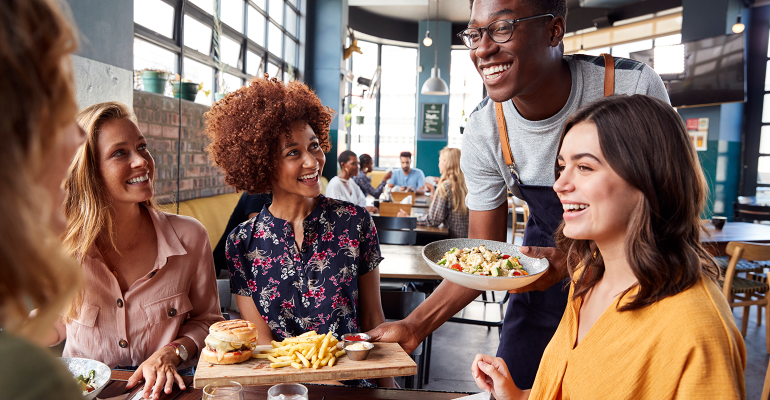The full-service segment continues to reel from pandemic-related challenges as well as consumers who are more convenience and speed minded. According to Technomic data, the full-service segment has lost three full percentage points of industry share in the past four years – 21% at the end of 2023 from 24% in 2019.
Where does the segment go from here? A group of full-service executives provided their thoughts during a Restaurant Leadership Conference panel in Phoenix Monday, titled, “The Future of Full Service,” moderated by Jonathan Maze and Sam Oches, respective editors-in-chief of Restaurant Business and Nation’s Restaurant News. The executives – Scott Gladstone, chief development officer and president, International of Dine Brands, Kelly MacPherson, chief technology and supply chain officer of Union Square Hospitality Group, James O’Reilly, CEO of Ascent Hospitality Management, and Kendall Ware, chief operating officer of Walk-On’s Sports Bistreaux, provided their insights about the biggest factors impacting the segment, such as changes to the tipping model and service fees, the price/value equation versus limited-service, off-premises growth, and technology priorities.
Tipping is at a tipping point, so to speak. There are market discrepancies over what the tip wage is, and more concepts, including limited-service concepts, are prompting tips at every transaction, generating tip fatigue among consumers. MacPherson said USHG’s experiment to end tipping in 2015 came to an end during Covid because inflation continued to grow and “we couldn’t compete with hospitality included.” Now, the company is trying to come up with a solution to ease customer anxiety, which is “very real when servers are standing over them with a device.”
“The question is how do you continue to enable tipping and be able to give the staff the best advantage, but also from a guest perspective reduce anxiety,” she said. “Not standing over the guest while they’re paying, it seems small, but it goes a long way from a guest perspective.”
Gladstone said restaurants can take a page from third party delivery, which uses pricing to offset inflation.
“Test, innovate, learn. The challenge (with service fees) is from a PR standpoint with consumers. Anytime someone adds fees for consumers can be perceived in a negative way,” he said. “But with rising costs and pressures on margins, operators need to find a way to pass that on tactically.”
Fees have become a big part of off-premises growth because of added components like packaging, but consumers are reaching a threshold, O’Reilly cautioned: “If you’re thinking about adding more fees, test before doing so. Also, be transparent. If your packaging costs you a lot more money, call it a ‘packaging fee.’ Consumers are smart and they care about these things.”
With those added fees and tipping in the mix, full service’s value perception has dropped below its limited-service peers and so concepts are wise to think about different strategies, like bundling, to be competitive, Gladstone said.
“One of the benefits of having a large marketing budget is we scream ‘value’ on TV. A big piece of that is reminding guests about LTOs and value offerings and re-training them on experience. I think consumers during Covid forgot that and we have to keep reminding them that you can get this great meal, experience, value, etc. that isn’t too far off from QSR,” he said. “Consumers have shifted to quicker occasions for last 15-to-20 years, and we have to keep fighting this.”
MacPherson said USHG is doubling down on experience and hospitality to achieve a stronger value perception, while Ware said Walk-Ons is doing the same. Of course, technology is playing a bigger role in that experience, and that is what full-service operators are trying to figure out now, including how off-premises fits in. Forty-five percent of Walk-On’s third-party delivery customers, for instance, are first-time guests.
“look at 3PD (third-party delivery) as a brand awareness platform and we push to make sure there is no down time, and make sure we’re putting our best food forward,” Ware said. “We’ve limited our menu with 3PD because we know certain items don’t travel well, so it’s about brand awareness and driving trial, then being strategic about driving them into first party.”
Consumer data drives that strategy and full-service operators should have such insights at the ready.
“It’s all about data at the end of the day – not just having it, but what you can do with it, getting to know and understand guests in a more intimate way so we can deliver special moments for people,” MacPherson said.
In addition to data analytics, other tech priorities for these full-service operators include functions, like mobile scheduling, that can make the employee experience better and also create more labor efficiencies – critical in an inflationary environment.
“Finding more ways to get creative on the labor said … We’re investing heavily there now,” Ware said.
Contact Alicia Kelso at [email protected]





